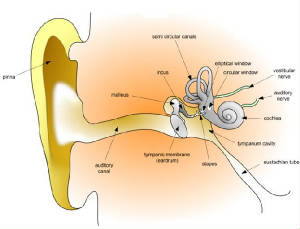Eardrum - Telephone
The eardrum is a marvel of engineering. As thin as tissue paper, it vibrates in response to the slightest changes in air pressure. If the eardrum surface moves inward a distance equal to the diameter of a single atom, one hundred millionth of a centimeter, a distinct sound is perceived. Clearly, a healthy eardrum is very sensitive. Alexander Graham Bell (1847-1922) was a professor of vocal physiology at Boston University. At this time, electronic communication was limited to the dots and dashes of Morse Code. In his research, Bell looked for ways to transmit the various frequencies or vibrations of the human voice. His study was motivated by the deafness of his mother and also his wife. Bell soon realized that the human ear provided the key to success. Bell noted that the bones of the inner ear amplified the slight vibrations of the eardrum. The signal then passed into the liquid-filled cochlea, or inner ear, where electrical signals were directed onward to the brain. In Bell’s words, “It occurred to me that if a membrane as thin as tissue paper could control the vibrations of bones that were, compared to it, of immense size and weight, why should not a larger and thicker membrane be able to vibrate a piece of iron in front of an electromagnet…?” Bell was describing the principle of both the microphone and the loudspeaker. From earphones to cell phones, voice and music transmission is modeled after the design of our eardrum. Psalm 139:14: “I praise you for I am fearfully and wonderfully made.”

